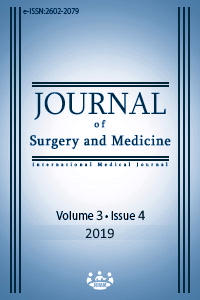Assessment of the white blood cell subtypes ratio in patients with supraventricular tachycardia: Retrospective cohort study
Keywords:
White blood cell subtypes, Supraventricular tachycardia, InflammationAbstract
Aim: Neutrophil/lymphocyte ratio (NLR), monocyte/lymphocyte ratio (MLR) and lymphocyte/monocyte ratio (LMR) have been considered to be the new cardiovascular risk predictors. Inflammation has been shown to be associated with various types of arrhythmia. This study aimed to investigate the relationship between NLR, LMR and MLR in patients with supraventricular tachycardia (SVT).
Methods: Our study included 59 patients aged 18 years or older who visited our clinic between December 2017 and December 2018. Thirty-three patients were diagnosed with definitive diagnosis of tachycardia using electrocardiographic (ECG) method, and hospitalized for ablation. The other 26 patients were the ones who underwent electrophysiological study (EPS) as it was not possible to make a diagnosis of arrhythmia using non-invasive methods despite ongoing complaints of palpitation. Blood samples were taken from all patients for pre-operative complete blood count analysis. NLR was calculated as the ratio of neutrophil count to lymphocyte count. MLR was calculated as the ratio of monocyte count to lymphocyte count. LMR was calculated as the ratio of lymphocyte count to monocyte count. In addition, electrophysiological study (EPS) was performed for treatment purposes in patients diagnosed with SVT; and for diagnosis and treatment purposes in patients who have the complaint of palpitation, however, could not be diagnosed using non-invasive methods.
Results: This study included 33 patients with SVT and 26 healthy controls who underwent EPS. When hematological parameters were compared, there was no statistically significant difference in NLR values (1.96 (0.69) 103/μL vs. 2.17 (1.29) 103/μL, p=0.42). Moreover, both MLR (0.25 (0.09) 103/μL vs. 0.22 (0.08)) 103/μL, p=0.19) and LMR (4.64 (1.37) 103/μL vs. 4.64 (1.45)) 103/μL, p = 0.49) were not statistically significant between the two groups.
Conclusion: This study showed that NLR, LMR and MLR values cannot be used as predictors for the presence of SVT.
Downloads
References
Tamhane UU, Aneja S, Montgomery D, Eagle KA, Gurm HS. Association between admission neutrophil to lymphocyte ratio and outcomes in patients with acute coronary syndrome. Am J Cardiol. 2008;102:653-7.
Uthamalingam S, Patvardhan EA, Subramanian S, Ahmed W, Martin W, Daley M, et al. Utility of the neutrophil to lymphocyte ratio in predicting long-term outcomes in acute decompensated heart failure. Am J Cardiol. 2011;107:433-8.
Huang G, Zhong XN, Zhong B, Chen YQ, Liu ZZ, Su L, et al. Significance of white blood cell count and its subtypes in patients with acute coronary syndrome. Eur J Clin Invest. 2009;39:348-58.
Horne BD, Anderson JL, John JM, Weaver A, Bair TL, Jensen KR, et al. Which white blood cell subtypes predict increased cardiovascular risk? J Am Coll Cardiol. 2005;45:1638-43.
Ross R. Atherosclerosis –an inflmamatory disease. N Engl J Med. 1999;340:115-26.
Klein RM, Vester EG, Brehm MU, Dees H, Picard F, Niederacher D, et al. Inflammation of the myocardium as an arrhythmia trigger. Z Kardiol. 2000;89 Suppl 3:24-35.
Chimienti M, Barbieri S. Treatment of supraventricular tachyarrhythmias: drugs or ablation? G Ital Cardiol. 1996;26(2):213-26.
Horne BD, Anderson JL, John JM, Weasver A, Bair TL, Jensen Kr, et al. Which white blood cell subtypes predict increased cardiovascular risk? J Am Coll Cardiol. 2005;45:1638-43.
Balta I, Balta S, Demirkol S, Celik T, Ekiz O, Cakar M, et al. Aortic arterial stiffness is a moderate predictor of cardiovascular disease in patients with psoriasis vulgaris. Angiology. 2014 Jan;65(1):74-8. doi: 10.1177/0003319713485805.
Balta S, Celik T, Mikhailidis DP, Ozturk C, Demirkol S, Aparci M, et al. The Relation Between Atherosclerosis and the Neutrophil-Lymphocyte Ratio. Clin Appl Thromb Hemost. 2016 Jul;22(5):405-11. doi: 10.1177/1076029615569568.
Frustaci A, Chimenti C, Bellocci F, Morgante E, Russo MA, Maseri A. Histological substrate of atrial biopsies in patients with lone atrial fibrillation. Circulation. 1997;96:1180-4.
Chung MK, Martin DO, Sprecher D, Wazni O, Kanderian A, Carnes CA, et al. C-reactive protein elevation in patients with atrial arrhythmias: inflammatory mechanisms and persistence of atrial fibrillation. Circulation. 2001;104:2886-91.
Osmancik P, Peroutka Z, Budera P, Herman D, Stros P, Straka Z, et al. Decreased Apoptosis following Successful Ablation of Atrial Fibrillation. European Cytokine Network. 2010;4:278-84.
Ocak T, Erdem A, Duran A, Tekelioglu U, Öztürk S, Ayhan S, et al. The importance of the mean platelet volume in the diagnosis of supraventricular tachycardia. Afr Health Sci. 2013;13(3):590-4.
Aydın M, Yıldız A, Yüksel M, Polat N, Aktan A, İslamoğlu Y. Assessment of the neutrophil/lymphocyte ratio in patients with supraventricular tachycardia. Anatol J Cardiol. 2016;16(1):29-33.
Chen Y, Zhang Y, Zhao G, Chen C, Yang P, Ye S, Tan X. Difference in Leukocyte Composition between Women before and after Menopausal Age, and Distinct Sexual Dimorphism. PLoS One. 2016;11(9):e0162953.
Lee JS, Kim NY, Na SH, Youn YH, Shin CS. Reference values of neutrophil-lymphocyte ratio, lymphocyte-monocyte ratio, platelet-lymphocyte ratio, and mean platelet volume in healthy adults in South Korea. Medicine (Baltimore). 2018;97(26):e11138.
Downloads
- 1278 1650
Published
Issue
Section
How to Cite
License
Copyright (c) 2019 Uğur Küçük, Mehmet Arslan
This work is licensed under a Creative Commons Attribution-NonCommercial-NoDerivatives 4.0 International License.
















